
Richard David De Wert was a United States Navy hospital corpsman who was killed in action during the Korean War while serving with a Marine Corps rifle company. He was posthumously awarded the nation's highest military decoration for valor, the Medal of Honor, for heroic actions "above and beyond the call of duty" on April 5, 1951, in South Korea.

David Robert "Bobby" Ray was a United States Navy hospital corpsman second class who was killed in action during the Vietnam War while assigned to an artillery battery of the United States Marine Corps. He was posthumously awarded the Medal of Honor for his heroic actions above and beyond the call of duty on March 19, 1969.
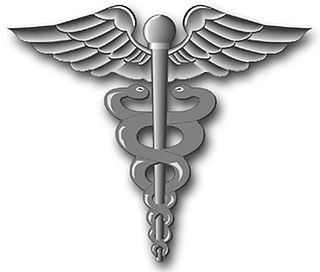
A hospital corpsman (HM) or corpsman is an enlisted medical specialist of the United States Navy, who may also serve in a U.S. Marine Corps unit. The corresponding rating within the United States Coast Guard is health services technician (HS).

William Richard Charette was a United States Navy master chief hospital corpsman who received the nation's highest military decoration for valor, the Medal of Honor. He was awarded the medal for heroic actions "above and beyond the call of duty" on March 27, 1953, while assigned to a Marine Corps rifle company during the Korean War. He retired from the Navy after 26 years of service.

The Battle of Abu Ghraib took place between Iraqi Mujahideen and United States forces at Abu Ghraib prison on April 2, 2005.

Major General Raymond Leroy Murray was a highly decorated United States Marine Corps officer who earned two Navy Crosses, one during World War II and a second during the Korean War. He retired from active duty on August 1, 1968.
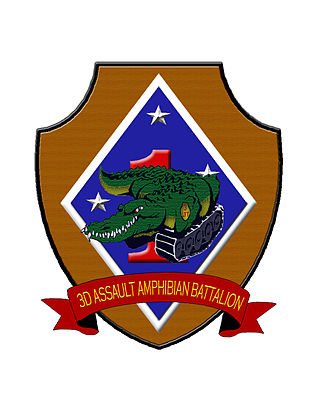
3rd Assault Amphibian Battalion is one of two active duty assault amphibian battalions in the United States Marine Corps. The battalion is tasked with transporting US Marine forces and their equipment from assault ships to shore, and equipped with the Amphibious Combat Vehicle (ACV), which replaced the Amphibious Assault Vehicle (AAV). The battalion is part of the 1st Marine Division and the I Marine Expeditionary Force. The unit is based in Camp Pendleton in California.

2nd Assault Amphibian Battalion is one of two active duty assault amphibian battalions in the United States Marine Corps. The battalion is tasked with transporting US Marine forces and their equipment from assault ships to shore, and equipped with the Amphibious Combat Vehicle (ACV), which replaced the Amphibious Assault Vehicle (AAV). The battalion is part of the 2nd Marine Division and the II Marine Expeditionary Force. The unit is based in Camp Lejeune in North Carolina.
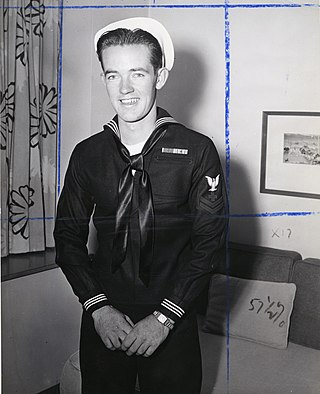
George E. Wahlen was a United States Army major who served with the United States Navy as a hospital corpsman attached to a Marine Corps rifle company in World War II and was awarded the U.S. military's highest decoration for valor, the Medal of Honor, for heroism above and beyond the call of duty during the Battle of Iwo Jima. He was an Army officer in the Korean War and was wounded in the Vietnam War.
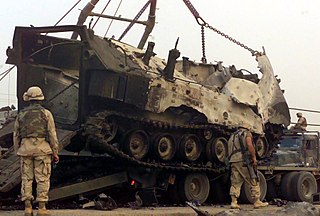
The Battle of Nasiriyah was fought between the US 2nd Marine Expeditionary Brigade and Iraqi forces from 23 March to 2 April 2003 during the US-led invasion of Iraq. On the night of 24–25 March, the bulk of the Marines of Regimental Combat Team 1 passed through the city over the bridges and attacked north towards Baghdad. However, fighting continued in the city until 1 April when Iraqi resistance in the city was defeated.
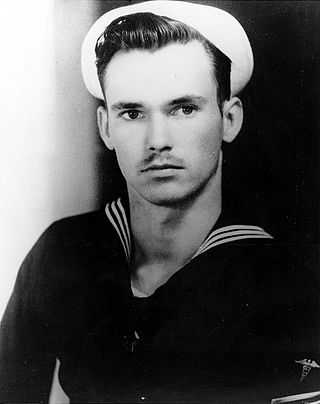
John Edward Kilmer was a United States Navy hospitalman who was killed in action during the Battle of Bunker Hill (1952) while attached to a Marine Corps rifle company in the Korean War. He was posthumously awarded the Medal of Honor for heroism above and beyond the call of duty on August 13, 1952.

Francis Junior Pierce was a United States Navy hospital corpsman in World War II who received the nation's highest military decoration for valor, the Medal of Honor. He was awarded the medal for heroic actions "above and beyond the call of duty" on March 15–16, 1945, while assigned to a Marine Corps infantry battalion during the Battle of Iwo Jima.

Donald Everett Ballard is a retired colonel of the Kansas National Guard and former member of the United States Navy. As a hospital corpsman in the Vietnam War, he received the Medal of Honor for his heroic actions on May 16, 1968.
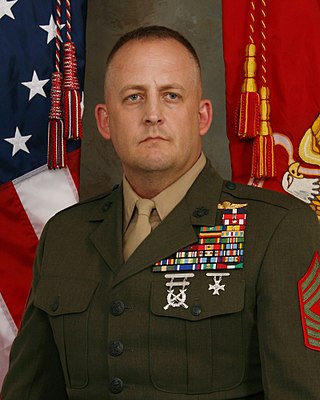
Justin D. LeHew is a United States Marine who served in the War on Terror. He was awarded the Navy Cross for his actions on 23 and 24 March 2003 during the initial 2003 invasion of Iraq. He was hand picked to spearhead the rescue operation and recovery of the U.S. Army's 507th Maintenance Company on 23 March and subsequently was called upon again to take part in the rescue operation of US Army Private Jessica Lynch on 1 April 2003. He is also a recipient of the Bronze Star with Combat Distinguishing Device denoting Valor for his heroic actions from 5 to 28 August 2004 during the Battle of Najaf.
Fred Faulkner Lester was a United States Navy hospital corpsman who was killed in action during World War II while assigned to a Marine Corps rifle company. He was posthumously awarded the nation's highest military decoration for valor, the Medal of Honor, for heroic actions "above and beyond the call of duty" on June 8, 1945, during the Battle of Okinawa.
Hispanics in the United States Navy can trace their tradition of naval military service to men such as Lieutenant Jordi Farragut Mesquida, who served in the American Revolution. Hispanics, such as Seaman Philip Bazaar and Seaman John Ortega, have distinguished themselves in combat and have been awarded the Medal of Honor, the highest military decoration of the United States. Hispanics have also reached the top ranks of the navy, serving their country in sensitive leadership positions on domestic and foreign shores. Among those who have reached the highest ranks in the navy are Commodore Uriah Phillips Levy, of Sephardic and Ashkenazic Jewish descent, who participated in the War of 1812 as an assistant Sailing master; Admiral David Glasgow Farragut, for whom the rank of admiral in the U.S. Navy was created during the American Civil War; and Admiral Horacio Rivero, who led the navy during the Cuban Missile Crisis.

A Special Amphibious Reconnaissance Corpsman (SARC) is a United States Navy hospital corpsman who provides MARSOC and other USSOCOM units advanced trauma management associated with combatant diving and parachute entry. Traditionally, they are attached to the Marine Corps Force Reconnaissance companies to help support the Command Element of the Marine Air-Ground Task Force in special reconnaissance missions.

The Marine Raider Regiment (MRR), formerly known as the Marine Special Operations Regiment (MSOR), is a special operations force of the United States Marine Corps, which is a part of Marine Corps Special Operations Command (MARSOC). Renamed for its predecessor, the World War II Marine Raiders, this unit is the principal combat component of MARSOC, which is the Marine Corps' contribution to the United States Special Operations Command (USSOCOM).

Mark L. Donald is a retired United States Navy SEAL, hospital corpsman, and physician assistant who served in the United States Navy. Donald is one of the few American warriors to have earned three high-level combat valor medals for displaying the highest levels of battlefield heroism on more than one occasion. Donald, a recipient of the Navy Cross and Silver Star awards in support of Operation Enduring Freedom during the fall of 2003 and the Bronze Star with V device denoting combat heroism for Operation Iraqi Freedom during the spring of 2003, is one of the most decorated heroes of the War on Terror.
Tomas V. Campo, Jr. was a hospital corpsman of the Philippine Marine Corps and a posthumous recipient of the Philippines' highest military award for courage, the Medal of Valor. Sergeant Campo served with the 20th Marine Company of Marine Battalion Landing Team-10 during the 2000 Philippine campaign against the Moro Islamic Liberation Front. In a military operation to capture Camp Bilal, an MILF stronghold in Munai, Lanao del Norte, Campo came to the aid of 10 Marines wounded by hostile fire, pulling them to safety and treating their wounds. As he attempted to rescue an 11th casualty, he was hit by enemy fire and killed in action.
























